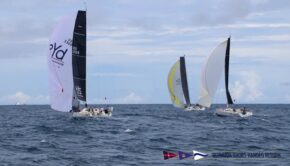A Story of Hard Charging
Published on March 28th, 2022
by Peter Becker
Last spring, I sailed an amazing race called the Bermuda 1-2. The first leg to Bermuda is sailed single-handed followed by a double-handed return to Newport. The solo offshore part was particularly rewarding and a great awakening to the joys of solo sailing.
Short-handed sailing is so much fun that with the help of the New York Yacht Club, the Royal Bermuda Yacht Club, and the Cruising Club of America, we started a new race, the Bermuda Short-Handed Return, a single- and double-handed race back to Newport shortly after the Newport Bermuda Race.
Now for the first time, hard-charging short-handed sailors can race to and from Bermuda every year!
The Young American Sailing Academy has two J/105s that are constantly being upgraded and modified for short-handed offshore sailing. I’ve done a lot of sea miles, but I never expected that among the many lessons learned, the one that stood out the most was the importance of battery management and the importance of effective charging.
The power consumption adds up when running the autopilot, laptop, and electronics. Unfortunately, the boats are not configured with amp meters, so, it is hard to know exactly how many amp-hours of power is used per day, but what I do know is that we ran the engine four times a day for two hours each time.
Eight hours of charging per day! That is crazy! And all that focus on battery management and engine running is certainly distracting from sailing fast and winning races.
The boat is set up with two battery banks – one reserved for engine start and the other a 150 Ah LifeLine AGM battery for the house. The engine is an 18 HP Yanmar 2GM20-F with a standard Hitachi 55-amp alternator.
The boat’s fuel tank holds 13 gallons, and I estimate the engine burns 0.3 gal/hour while charging. Despite the modest fuel burn, the tank is not large enough to provide the sufficient fuel used to support the eight hours of charging per day for a four-to-five day passage and still have anywhere enough fuel remaining at the finish to meet the race safety requirements of motoring 100 nm.
I probably arrived in Bermuda after the five-day single-handed leg with two to three gallons of fuel remaining. I did not foresee this situation at all.
This spring we are again racing to and from Bermuda, this time double-handed both in the Newport Bermuda Race and in the Bermuda Short-Handed Return race. So, the next level of modification to the boats begins with upgrading the batteries and the charging system. The following is what we are learning and what we are planning:
Alternators & Regulators
If you have the standard alternator with a “dumb” internal regulator, as I do, you should know it is not your friend and it is probably killing your battery slowly with improper charging voltage and charge rate.
The first thing to do is to change to an alternator system that uses an external “smart” regulator. My 55-amp Hitachi has an internal regulator which is designed to simply protect the alternator itself. The Hitachi alternator would need to be modified by adding a field post to work with an external regulator.
Our solution is to get rid of that one and change to a larger alternator that works with a “smart” regulator. We are upgrading and going with a shiny new ElectroMaax 140 Amp alternator.
Drive Belts:
Our older Yanmar 2GM20F is equipped with standard V-belts driving the alternator. The problem with V-belts is they tend to slip when the alternator is loaded with the result of filling your engine box with black belt dust. The 140-amp alternator would destroy the V-belt on the engine.
The solution is to upgrade to a serpentine belt, which is flat and has more surface on the pulleys to reduce slippage. Fortunately, there are simple conversion kits from several companies to convert from the V-belt to a serpentine belt. Again, we are going with a belt kit from ElectroMaax.
Charging:
The huge benefit of a “smart” regulator is that it can be programmed precisely to deliver the charging profile that your battery needs to be happy and fully charged. For example, AGM batteries are properly charged with a three-stage profile; first, a bulk charge at the maximum current that the alternator supplies until the battery isn’t taking that maximum current, then a constant-voltage absorption charge stage, and then to a float charge.
The painful problem is that with dumb regulators like in the Hitachi, there is only one charge voltage, the float voltage, which means the battery can only take a charge at an extremely slow rate. That means that you either run your engine for a super long time or settle for never fully charging up your battery. Our solution is to upgrade to a “smart” regulator from ElectroMaax.
Upgrading to the new alternator, adding the serpentine drive belts and the “smart” regulator, we will be able to reduce the charge time down to 40 minutes per charge for a total of 2.5 hours per day. That is approximately a 70% reduction in charge time!
The assumptions are that the 140 amp alternator is set to deliver 90 amps and that the battery can absorb current at a rate of 0.6c as a bulk charge. In this setup with the AGM battery, we are still not fully charging the battery to 100% state of charge (SoC) with the alternator.
As mentioned earlier, lead-acid batteries such as an AGM will be slowly and prematurely put to their death by both improper “dumb” charging and failure to charge to 100% SoC. Knowing that our “dumb” alternator/regulator was incapable of fully charging the AGM batteries, we installed a Sterling ProCharge Ultra Battery “smart” multi-stage Charger before the Bermuda 1-2.
Using the AC/DC charger and working off shore-power, the charger would at least guarantee that the boat departs for the starting line with 100% charged batteries.
LiFePO4:
Now for the Big Upgrade: changing out the AGM house bank batteries for Lithium Iron Phosphate (LiFePO4) batteries. The LiFePO4 batteries have desirable characteristics like maintaining a steady voltage despite the SoC and being able to take bulk charging right up to almost 100% SoC.
As compared to AGM, LiFePo4 batteries have a much greater usable capacity range and will provide significantly more life cycles of discharge. LiFePO4 does not need to get back to 100% SoC like with AGM to reduce the effects of sulfation.
We understand that LiFePO4 batteries are happy to be stored at 30-65% SoC rather than at 100% SoC, and they are easy to cycle from 20%-90% of charge. This should not only reduce the headache of managing the health of the batteries but also lead to significantly longer service life.
Upgrading to LiFePO4 is not straightforward. It is advised that one seeks design help from professionals and with the installation. It should be noted that some of the battery wires may need to be changed and that the LiFePO4 battery system needs a battery management system (BMS).
The “drop-in” batteries have a BMS system internal to the battery specifically to protect the battery. External BMS systems are more complex and provide communication between various components of the electrical system. Our electrical system and loads are simple compared to that of a cruising boat; so, we can get away with LiFePO4 batteries with internal BMS.
Engine Start:
LiFePO4 are great house batteries, however, some drop-in LiFePO4 batteries are not great at serving as an engine start bank due to the limitations of the maximum current due to internal circuitry. We are maintaining a separate AGM battery dedicated to the engine starting. We will use a DC/DC converter to use energy from the house bank to keep the engine start bank charged.
Review:
This is still a work in progress, but we are super excited to complete the installation and report back with the actual comparison results – and eager for the joy of only having to charge twice a day for 30 minutes each time. This will remove a significant distraction and allow a much greater focus on hard-charging in the sailing sense.
Be happy! Change hard-to-charge into hard-charging.









 We’ll keep your information safe.
We’ll keep your information safe.